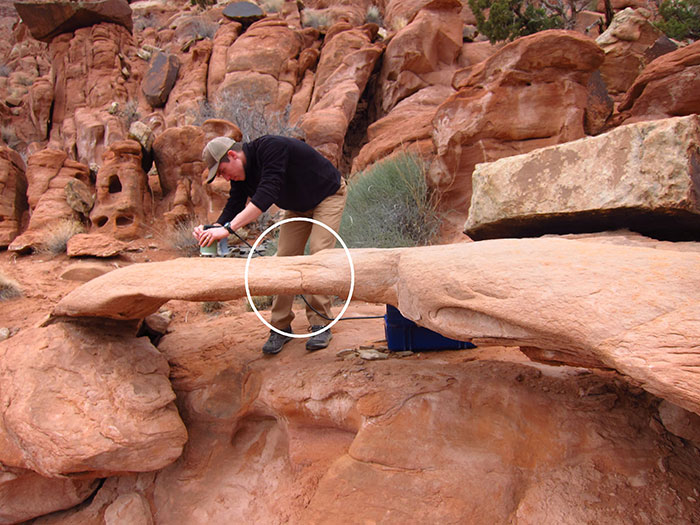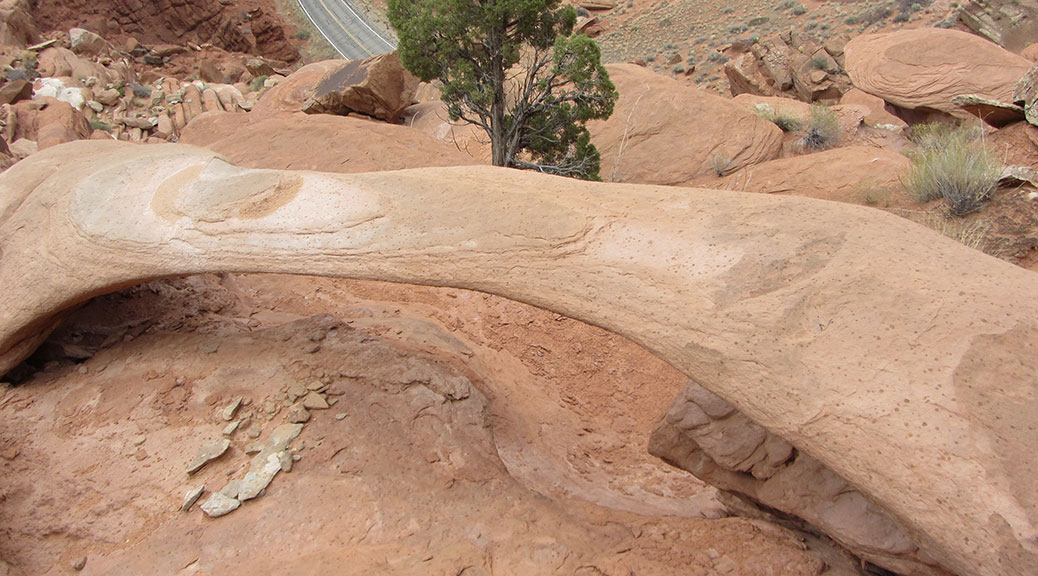Rainbow Arch, located just above the visitor center in Arches National Park, collapsed sometime this winter. A park ranger noticed it was no longer standing during a hike in February. The arch was cataloged by Stevens and McCarrick as SA-137 and had a reported span of 11.7 feet.
A research team from the University of Utah, including Jeff Moore and Paul Geimer, had actually been studying this arch not long before the collapse. The “before collapse” photos here were taken by Jeff Moore, and the “after collapse” photos were taken by Paul Geimer. The “before-after” comparison below was assembled by Holly Walker.
The team made vibration measurements four times at the site in 2017, focusing on a prominent crack working through the center of the span that appeared to be putting the structure in jeopardy. The crack is circled in the photo below.

Close-up photo of the crack before collapse:

However, the team observed no changes in the crack or vibration characteristics over 12 months, and backed off on their monitoring program, believing the arch to be more stable that it appeared.
The collapse is bittersweet for the team, as it highlights and validates the fragility of these features, but unfortunately they were unable to record its last few weeks and months and identify accumulating damage.
Below is a photo after collapse.

While they can’t say for certain what caused the collapse, they believe the most likely explanation is that fatigue caused by daily and annual heating cycles finally stressed the tip of the crack enough to cause a runaway failure sometime this past winter.
Rainbow Arch lives on in the virtual world as an interactive 3D model made by the research team that can be found at https://skfb.ly/VMvB.



How many years ago was this arch formed ?
Quantitative data and chances to determine the age of initial formation of an arch are actually quite rare. The best example we know is Rainbow Bridge, which formed as an entrenched meander bend in bedrock was punctured and cut off. Geologists have dated abandoned river terraces in the Glen Canyon region and used these to estimate rates of incision of the Colorado River. From these, the age of the initial puncture of the meander bend at Rainbow Bridge has been estimated to be about 30,000 years ago – this is reported by Chidsey et al. in Geology of Utah’s Parks and Monuments (2010). Obviously this is a very large natural bridge so not of comparable scale to Rainbow Arch, just one of the rare few examples where we have some data on the age of initial formation of a natural arch or bridge. Using Rainbow Bridge as a guide, and taking the large amount of debris under Rainbow Arch into consideration, it likely formed no more than a few thousand years ago and may have had its final shape for only a few decades prior to collapse
Are they going to reconstruct it ?
These arches a bit different than anything else that the forestry protects.
A bit after the fact – but if anyone has past photos of Rainbow Arch we would love to see them. The older the better but everything is appreciated. Please email to: jeff.moore@utah.edu
Thanks – Jeff Moore